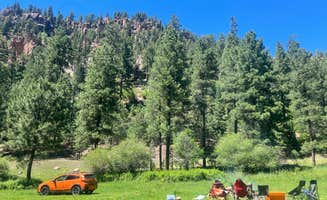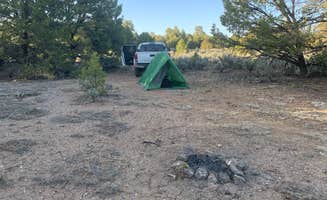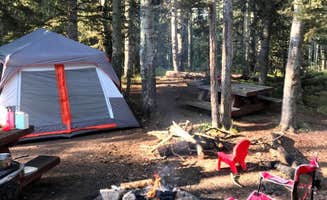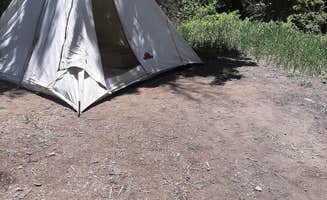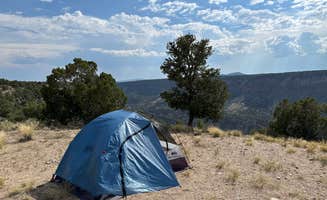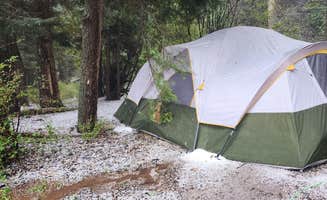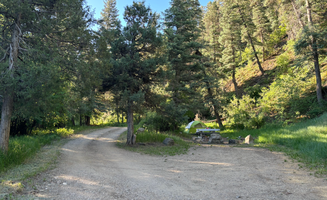Dispersed camping near Abiquiu, New Mexico offers secluded sites across elevations ranging from 6,000 to 10,000 feet in the Carson and Santa Fe National Forests. Most primitive camping areas experience dramatic temperature shifts, with overnight temperatures dropping 30-40 degrees from daytime highs even in summer months. Seasonal forest service road closures occur after significant precipitation, with many high-elevation sites inaccessible from November through April.
What to do
Kayak the Rio Grande: The Rio Grande provides excellent paddling opportunities near Taos Junction Campground. A camper notes, "The best part about camping here is you can kayak down the river. We always rent from a local rafting business. The tour guides have never failed to impress."
Fish for trout: Multiple lakes and streams offer fishing opportunities, particularly at Canjilon Creek. According to a reviewer, "It has three lakes filled with trout. Lots of areas to explore. Plenty of wood to forage for."
Stargazing: The minimal light pollution at higher elevation sites creates exceptional night sky viewing. At Forest Service Road 578, campers enjoy clear mountain views: "I could see the snow capped peaks of the Sangre de Cristo range on the eastern horizon when I walked farther up the road."
Wildlife viewing: Multiple campgrounds offer opportunities to spot elk, bighorn sheep, and other wildlife. One camper at Forest Service Road 578 reported, "I saw two elk across a swath of sage," while another mentioned seeing "big horn sheep elk" at Taos Junction.
What campers like
Natural water features: Many dispersed sites feature creeks that provide ambient sound. At Big Tesuque Campground, campers appreciate the "nice babbling brook alongside campsites, fun for kids to play in (COLD, but shallow), and makes for great white noise."
Solitude and privacy: Several camping areas offer well-spaced sites. A camper at Resumidero Camping Area explained, "We expected a campground that was spread out, fire rings and vault toilets. It was perfect. Hiking trails from the campground. Beautiful area."
Forest diversity: The region features varied ecosystems at different elevations. On Forest Service Road 578, a camper noted, "The forest is a nice mix of sage, juniper, and pine trees," while at Road 378 near Fenton Lake, another mentioned "a beautiful cliff view" at their campsite.
Elevation cooling: Higher elevation tent camping sites provide relief from summer heat. At Canjilon Creek Campground, a camper shared, "This park is very primitive. It has no running water, toilets, or amenities. What it has a lot of, is charm. The campground is at around 9,000 foot level."
What you should know
Road conditions: Many dispersed camping areas require high-clearance vehicles. At American Springs, a camper advised, "Probably not a must have, but I highly recommend a four-wheel-drive high clearance to get back into the camp spots here."
Temperature fluctuations: High elevations create cold nights year-round. A camper at Road 378 by Fenton Lake warned, "It does get cold at night since at approximately 8,000 elevation."
Varying amenities: Facilities differ dramatically between established and dispersed sites. At Big Tesuque, campers find "basic toilets. No showers, no sinks. But there are 2 streams bordering the campground and trails leading into the mountains."
Cell service limitations: Connectivity drops quickly away from highways. A Forest Road 578 camper reported, "Cell service drops completely pretty soon after leaving the highway. I sporadically received some messages at my camp site but not reliably."
Seasonal accessibility: Higher elevation sites have limited access in winter. A camper at Big Tesuque noted, "Road is paved all the way and regularly plowed during the cold seasons. I'm sure this is very busy during the warm seasons but we had the place to ourselves during the week in early December."
Tips for camping with families
Look for water features: Children enjoy playing in shallow streams at certain campgrounds. A Big Tesuque camper mentioned their site had a "nice babbling brook alongside campsites, fun for kids to play in (COLD, but shallow)."
Pack for temperature changes: Even summer camping requires warm clothing for children. At Aspen Basin Campground, a camper noted it was "Chilly in mid October visit. Aspens are gorgeous on the drive up."
Select sites with shorter hikes: Some campsites require carrying gear uphill. A Big Tesuque camper advised, "essential hike in, uphill, have to carry your gear. The further in your campsite, the more hiking you will do (we chose one close to the parking lot, but sacrificed privacy)."
Consider tent pad size: Family tent configurations may require adaptation. A Big Tesuque reviewer shared, "campsite tent pads are small/limited. Our family of 6 usually would use 3 small tents, but had to limit ourselves to 2, so everyone was squeezed together."
Tips from RVers
Scout pullouts when possible: Dispersed camping areas may have limited turning space. At Cuba Hwy Pulloff on Forest Road 88, a camper noted, "beginning of has limited spots (25' or less total length) as you start going up the road it gets way rutted / washboarded out."
Use designated RV areas: Many primitive sites are unsuitable for larger vehicles. A Cuba Highway reviewer advised, "The road in is steep for long rigs. It's a bummer people throw so much trash and glass bottles around."
Consider seasonal timing: Forest roads deteriorate after precipitation. A Forest Road 578 camper warned, "My Tacoma had no problem on the dirt road, which has ruts and might be tough for an RV."
Prepare for no hookups: Bring generators if traveling with pets in summer. A Cuba Highway camper explained, "We decided to boondock here for the night with a generator for AC (traveling with dogs)."


